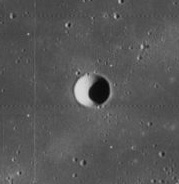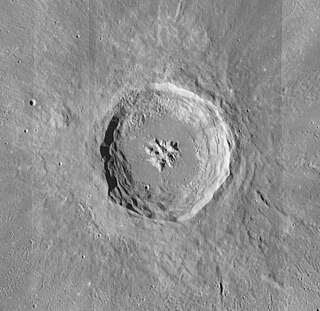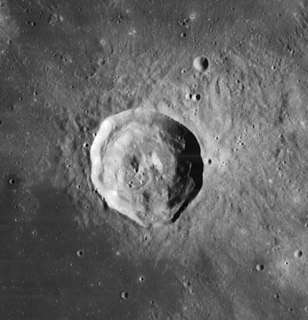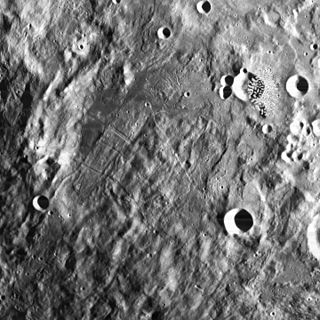
Anaxagoras is a young lunar impact crater that is located near the north pole of the Moon. It lies across the larger and more heavily worn crater Goldschmidt. To the south-southeast is Epigenes, and due south is the worn remains of Birmingham.

Zinner is a tiny lunar impact crater located due north of the crater Schiaparelli on the Oceanus Procellarum. It is circular and cup-shaped, with a high albedo in comparison to the surrounding lunar mare. The crater has essentially no rim because the mare lava nearly flooded it. A ray from the crater Glushko crosses Zinner. To the northwest is the slightly larger crater Golgi. East of Zinner is the Dorsa Burnet wrinkle ridge system.

Censorinus is a tiny lunar impact crater located on a rise to the southeast of the Mare Tranquillitatis. It is named after the ancient Roman writer Censorinus. To the northeast is the crater Maskelyne.

Taruntius is a lunar impact crater on the northwestern edge of Mare Fecunditatis. It was named after ancient Roman philosopher, mathematician and astrologer Lucius Tarutius Firmanus. To the northwest is the lava-flooded crater Lawrence, and to the north lie the craters Watts and da Vinci.

Faraday is a lunar impact crater in the southern highlands of the Moon. It was named after British chemist and physicist Michael Faraday. It lies across the southeast rim of the larger crater Stöfler, and the northwest rim of Faraday forms a wide rampart across the otherwise flat floor of Stöfler. To the east of Faraday is Maurolycus.

Aristillus is a prominent lunar impact crater that lies in the eastern Mare Imbrium. It was named after Greek astronomer Aristyllus. Directly to the south is the smaller crater Autolycus, while to the southwest is the large Archimedes. To the northeast are the craters Theaetetus and Cassini.

Autolycus is a lunar impact crater that is located in the southeast part of Mare Imbrium. The crater is named after the ancient Greek astronomer Autolycus of Pitane. West of the formation is Archimedes, a formation more than double the size of Autolycus. Just to the north is Aristillus, and the outer ramparts of these two craters overlap in the intermediate stretch of the lunar mare.

Cardanus is a lunar impact crater that is located in the western part of the Moon, in the western part of the Oceanus Procellarum. Due to its location the crater appears very oval because of foreshortening, and it is viewed almost from the side.

Eudoxus is a prominent lunar impact crater that lies to the east of the northern tip of the Montes Caucasus range. It is named after the Greek astronomer Eudoxus of Cnidus. It is located to the south of the prominent crater Aristoteles in the northern regions of the visible Moon. To the south is the ruined formation of Alexander, and the small crater Lamèch lies to the southwest.

Kepler is a lunar impact crater that lies between the Oceanus Procellarum to the west and Mare Insularum in the east. To the southeast is the crater Encke. Kepler is named for the 17th century German astronomer and mathematician Johannes Kepler.

Manilius is a lunar impact crater on the northeast edge of Mare Vaporum. Its diameter is 38 km.

Reiner is a lunar impact crater on the Oceanus Procellarum, in the western part of the Moon. It has a nearly circular rim, but appears oval in shape due to foreshortening. The rim edge is well-defined and has not been eroded by impacts. In the midpoint of the irregular crater floor is a central peak. Outside the rim is a hummocky rampart that extends out across the mare for about half a crater diameter.

Olbers is a lunar impact crater that lies at the west edge of the Oceanus Procellarum, near the western limb of the Moon. It lies to the northwest of the crater Hevelius, and to the north of the indistinct Hedin. Farther to the south is the crater Riccioli. Due to its location, this crater appears very oblong because of foreshortening. It is viewed nearly edge-on, making observation of the interior difficult from the Earth.

Atwood is a small earth moon impact crater that is located on the Mare Fecunditatis, to the northwest of the prominent crater Langrenus. It forms a triple-crater formation with Naonobu attached to the north rim and Bilharz near the west rim.

Chamberlin is a lunar impact crater that is located on the far side of the Moon, just past the southeastern limb. It lies to the southeast of the crater Jeans, and Moulton is attached to the southeastern rim of Chamberlin. This crater is located in a part of the lunar surface that has undergone resurfacing of crater interiors, producing dark-hued crater floors.

Carpenter is a lunar impact crater in the northern part of the Moon, relatively close to the limb. At this position the crater is foreshortened and appears oval in shape. It is, however, very nearly circular in outline. The outer rampart to the south is adjoined to the old crater Anaximander, and the satellite formation Anaximander B lies along the western rim. To the northeast is Anaximenes.

Hedin is a lunar impact crater of the dimension traditionally termed a walled plain. It lies due south of the crater pair Olbers and Glushko, and northwest of the similarly dimensioned walled plain Riccioli. To the east is another walled plain, Hevelius.

Crookes is a lunar impact crater that lies on the Moon's far side as seen from the Earth. It lies just to the southwest of the giant crater Korolev. To the southwest of Crookes is McKellar.

Das is a lunar impact crater on the far side of the Moon. It is located to the northwest of the walled plain Chebyshev. To the southwest of Das is the irregular crater Mariotte, and Von der Pahlen lies to the east-northeast. The crater was named after Indian astronomer Anil Kumar Das.

Fowler is a large lunar impact crater that lies in the northern hemisphere on the Moon's far side. It lies to the south-southwest of the crater Esnault-Pelterie, and north of Gadomski. Overlying the eastern rim and intruding into the interior is Von Zeipel.





















